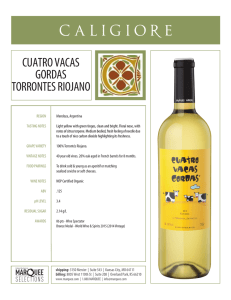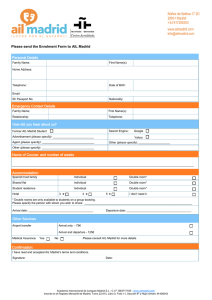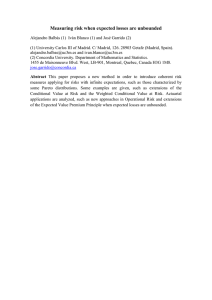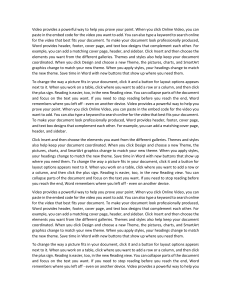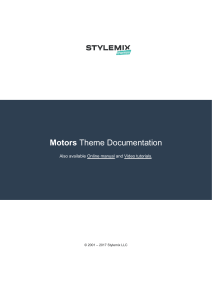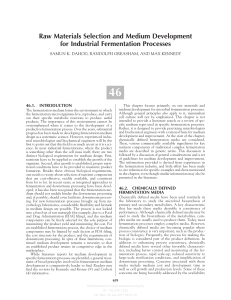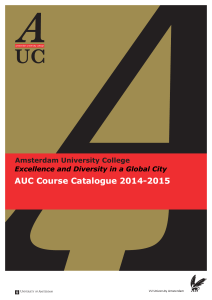Alcoholic Beverages Technology
Anuncio
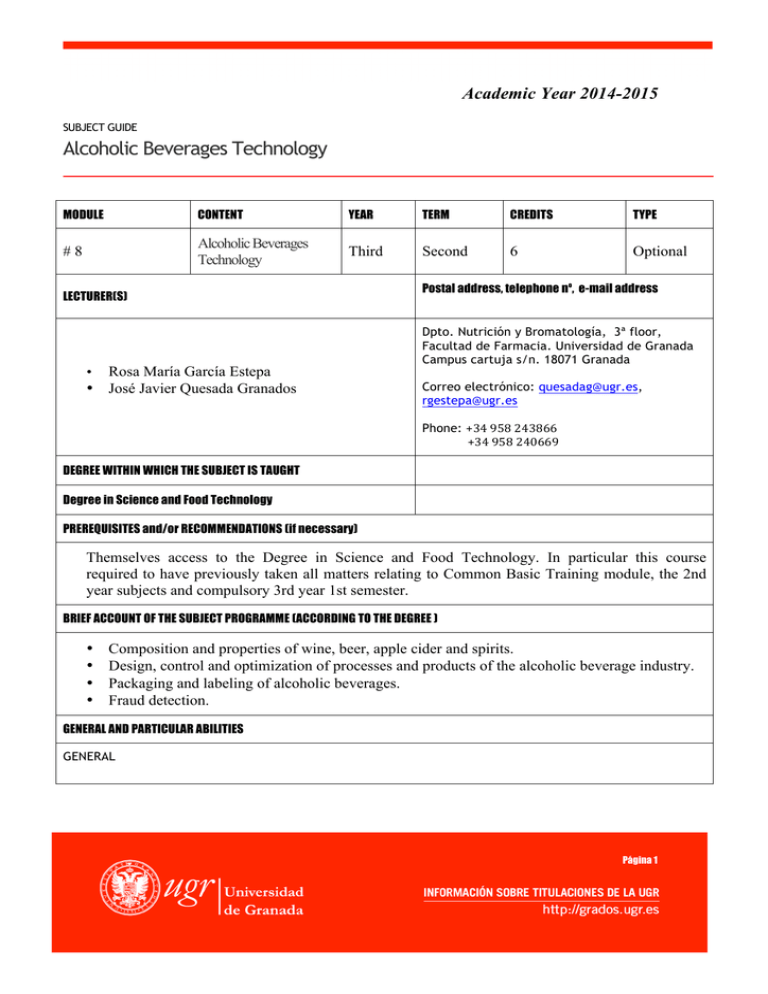
Academic Year 2014-2015 SUBJECT GUIDE Alcoholic Beverages Technology MODULE CONTENT YEAR TERM CREDITS TYPE #8 Alcoholic Beverages Technology Third Second 6 Optional LECTURER(S) Rosa María García Estepa • José Javier Quesada Granados Postal address, telephone no, e-mail address Dpto. Nutrición y Bromatología, 3ª floor, Facultad de Farmacia. Universidad de Granada Campus cartuja s/n. 18071 Granada • Correo electrónico: quesadag@ugr.es, rgestepa@ugr.es Phone: +34 958 243866 +34 958 240669 DEGREE WITHIN WHICH THE SUBJECT IS TAUGHT Degree in Science and Food Technology PREREQUISITES and/or RECOMMENDATIONS (if necessary) Themselves access to the Degree in Science and Food Technology. In particular this course required to have previously taken all matters relating to Common Basic Training module, the 2nd year subjects and compulsory 3rd year 1st semester. BRIEF ACCOUNT OF THE SUBJECT PROGRAMME (ACCORDING TO THE DEGREE ) • • • • Composition and properties of wine, beer, apple cider and spirits. Design, control and optimization of processes and products of the alcoholic beverage industry. Packaging and labeling of alcoholic beverages. Fraud detection. GENERAL AND PARTICULAR ABILITIES GENERAL Página 1 Core and Transverse University Competencies included in the Grade Verification Report on Science and Technology of Food PARTICULAR • Knowing the food production models, composition and physical properties, physico-chemical and to determine its nutritional value and functionality. • Learn the techniques and food analysis to ensure optimal conditions for human consumption. • Recognize and apply basic operations of major industrial processes to ensure process control and foodstuffs intended for human consumption. • Know, understand and apply the classical methodology and new technological processes aimed at improving the production and processing of food. • Apply food hygiene standards to design industries, as well as food products and processes, to ensure food safety management according to established legal framework. OBJECTIVES (EXPRESSED IN TERMS OF EXPECTED RESULTS OF THE TEACHING PROGRAMME) • • • • • • • • • • • • • • • Knowing raw materials for the production of wine. To study the changes and improvement techniques must suffer harvest and wine, necessary for obtaining a quality wine. Specify fermentation processes that occur during winemaking. Learn the most common types of wine that can be given in winemaking. To study the basic processes of correction and stabilization of the wine before bottling, as a guarantee of preservation. Assimilate the main quality control techniques of a wine. Knowing raw materials for the production of beer. To study the changes and fermentation processes that must suffer cereals and malt to become beer. Specify the types of beers and their characteristics. Assimilate control techniques beer quality. Know the process for of making apple cider Knowing the types and characteristics of different spirits. Assimilate the various methods of making distilled spirits. Study the importance of aging processes on liquor and its relation to fraud. Specify quality control techniques distilled spirits. DETAILED SUBJECT SYLLABUS THEORETICAL PROGRAM MODULE I. WINE TECHNOLOGY THEME 1. Concept and definition of Enology and wine. History of oenology. The vocabulary of oenology. Social and economic importance of the wine industry. The winemaking as a multidisciplinary science. European regulations and Spanish wine sector. Página 2 THEME 2. Origin and evolution of the vine. Defining ampelography. Genetic erosion of the vine. Vineyard baffle systems. Wine varieties of grapes. THEME 3. Chemical composition of grape berry. Influence of soil and climate on the chemical composition of the grapes. Changes in chemical composition during ripening. Control Techniques maturation. Maturity indices. THEME 4. Diseases of the vine. Influence on grape quality. Treatments to palliate the effects on the vine and grape. THEME 5. The harvest. Types vintage. harvest containers. Vintage transport to the winery. Factors that may affect the quality of the vintage. THEME 6. The cleanliness and hygiene of the winery and its importance. Corrections vintage. THEME 7. Alcoholic fermentation and yeast. Development of alcoholic fermentation. General characteristics of the yeast. Useful yeast species. Yeast species harmful. Employment of yeasts in winemaking. Behavior of the alcoholic fermentation. Factors influencing the development of alcoholic fermentation. THEME 8. The malolactic fermentation and lactic acid bacteria. Nature of malolactic transformation. The malolactic fermentation bacteria. Behavior of malolactic fermentation. Terms of malolactic fermentation. Crop Planting and malolactic employment. Alterations of wine per share of lactic acid bacteria. THEME 9. Mechanical operations for treatment of grapes in red wine vinification. Local fermentation. Barreling devices. Control of fermentation. Cessation of fermentation. THEME 10. Importance of maceration in red winemaking. Laws of maceration. Length of maceration. Time of racking. Pressing. Techniques recent use. Carbonic maceration. Winemaking continuously. THEME 11. Types of white wines. Collection of white wine grapes. Vintage mechanical treatment white. Racking. Types of racking. THEME 12. Effects of oxidation on white wine. Preventing the effect of oxidation. Behavior of fermentation in white wine production. THEME 13. Maturation and aging of wines. Role of oxygen. Changes of color. Amendments to the "bouquet". Aging in wood. Conditions of aging in bottle. Accelerated aging. THEME 14. Special vinification. Examples of special vinification (sparkling wines and generous). THEME 15. Sulfur dioxide in winemaking. Properties and forms of employment. THEME 16. Notions of clarity, clarification and stabilization. Types of clarifications in the wine. Fundamentals of stabilization procedures. Stabilizing means of a wine. Alterations of clarity. THEME 17. The container of wine. Glass bottle. Glass color. Bottling operations. Cork. Other types of caps. Capping the bottles. Current trends in wine packaging. THEME 18. Grape must. Mistelas. Vermouth. Wines with low alcohol and dealcoholized. MODULE II. TECHNOLOGY OF BEER THEME 19. Definition of beer and brewery. History of the brewery. European and Spanish regulations on beer. Bibliography. THEME 20. Raw materials in the brewing. Cereals. Malt. Getting malt. Hops. Aids or attachments. Water. Página 3 Yeasts. THEME 21. cooling the THEME 22. THEME 23. THEME 24. THEME 25. Handling and transportation of raw materials. Conditioning. Preparation of wort. Boiling and wort. Microbiology in brewery. Fermentation of wort. Postfermentación. Maturation of beer. Types of beers. Light beers. Nonalcoholic beer. Finishing processes of beer. Leaks. Carbonation. Storage tanks. Bottling. Other packaging. Pasteurization. Storage and distribution. MODULE III. TECHNOLOGY APPLE CIDER THEME 26. Definition of Apple Cider. History of apple cider. Law. Material: Variety, composition and production of apple cider. Indices of fruit quality. THEME 27. Technology apple cider. Obtaining apple juice. Clarification prefermentative. Alcoholic and malolactic fermentation. Clarification postfermentative. Maturation. Bottling. Apple cider alterations and corrections. MODULE III. TECHNOLOGY DISTILLED BEVERAGES THEME 28. Distilled beverage definition. History of the distillery. General Regulations on European and Spanish spirits and liquors. Bibliography. THEME 29. Early distillation. Types distillers. Types of distilled spirits. Spirits. Congeneric Distillates. Noncongeneric. Distillates THEME 30. Whisky. Definition. Types of whiskey. Legal definitions of whiskey. Preparation of whiskey. Technology in the production of whiskey. Aging. Specific regulations. THEME 31. Rum. Definition. Types of rum. Preparation of rum. Technology for the production of rum. Aging. Specific regulations. THEME 32. Brandy. Definition. Types of Brandy. Preparation of brandy. Technology in the development of brandy. Aging. Brandy de Jerez. Cognac and Armagnac. Specific regulations. THEME 33. Other spirits congeneric. Fruit brandies. Gin. Definition. Development of gin. Technology in the development of gin. Specific regulations. THEME 34. Noncongeneric Distillates. Vodka. Marc. Aquavit. Sake. Grappa. Anises. Arrack. Tequila. Mezcal. Legislation. THEME 35. Liquors. Definition. Classification of liquors. Processes. Specific regulations. New distilled beverages and cocktails. THEME 36. Fraud distilled beverages. "Jug". Accelerated aging. Packaging. Labelling. New trends in the packaging of distilled spirits. PRACTICAL PROGRAM 1. Analytical determinations specific to the quality control of wine and related beverages, beer and distilled spirits. 2. Visit Winery, brewery or distillery. READING • • • • • ALEIXANDRE BENAVENT, J.L. 1999. Vinos y bebidas alcohólicas. Universidad Politécnica de Valencia, Servicio de Publicación. Valencia. ALEIXANDRE BENAVENT, J.L., ALEIXANDRE TUDÓ, J.L. 2010. Manual de vinos y bebidas. Universidad Politécnica de Valencia. Servicio de Publicación. Valencia. ANZALDUA-MORALES, A. 1994. La evaluación sensorial de los alimentos en la teoría y la práctica. Ed. Acribia, S.A. Zaragoza. BUJÁN, J. 2003. Guía de la Nueva Cultura del Vino. Introducción y práctica. Ed. Rubes, S.L. Barcelona. BUJAN, J. ARTAJONA, J. 1994. La cata. Cuadernos del vino. Producción editorial Página 4 • • • • • • • • • • • • • • • Wilco comunicaciones S.L. BUJAN, J. ARTAJONA, J. 1996. Enología. Cuadernos del vino. Ed. Freixenet, Barcelona. FLANZY, C. (Coord.). 2003. Enología: fundamentos científicos y tecnológicos. 2ª edición. Ed. A. Madrid Vicente. Madrid. HIDALGO TOGORES, J. 2003. Tratado de Enología. Vol. I y II. Ed. Mundi-Prensa. Madrid. HORNSEY, I.A. 2002. Elaboración de cerveza: microbiología, bioquímica y tecnología. Ed. Acribia S.A. Zaragoza. HOUGH, J.S. 1990. Biotecnología de la cerveza y de la malta. Ed. Acribia S.A. Zaragoza. JEANTET, R. GROGUENNEC, TH., SCHUCK, P., BRULÉ, G. 2010. Ciencia de los alimentos: bioquímica, microbiología, procesos, productos. Ed. Acribia, S.A. Zaragoza. MADRID, A. 1987. Manual de Enología práctica. Ed. Mundi-Prensa. Madrid. MADRID, A. 1991. Tecnología del vino y bebidas derivadas. Ed. Mundi-Prensa. Madrid. MANGAS, J.J. 1996. Guía práctica de la elaboración de la sidra artesana. Ed. Unidad de transferencia y coordinación del CIATA. Consejería de Agricultura. Principado de Asturias. MARECA CORTES, I. 1983. Origen, composición y evolución del vino. Ed. Alhambra. S.A. Madrid. MIJARES, Mª I, SÁEZ ILLOBRE, J.A. 1998. El vino, de la cepa a la copa. Ed. MundiPrensa. Madrid. PEYNAUD, E. 1987. El gusto del vino: el gran libro de la degustación. Ed. MundiPrensa. Madrid. RUIZ HERNANDEZ, M. 1991. Vinificación en tinto. Ed. A. Madrid Vicente. Madrid. TINTÓ, A., SÁNCHEZ, F., VIDAL, J.M., VIJANDE, P. 2006. La cerveza artesanal. 2ª edición. Ed. CerveArt, S.L. Sabadell. VV.AA. 1983. La Cata De Los Vinos. 4ª edición. Ed. Agrícola Española, S.A. Madrid. ADDITIONAL BIBLIOGRAPHY • • • • • • • • GARCÍA DE LUJÁN, A. 1990. Variedades de vid en Andalucía. Ed. Dirección General de Investigación y Extensión Agraria, Sevilla. JEFFS, J. 1994. El vino de Jerez. Ed. Universidad de Cádiz. Cádiz. JOHNSON, H. 1986. El vino: Atlas mundial de vinos y licores. Ed. Blume. Barcelona. MARRO, M. 1989. Principios de viticultura. Ed. CEAC, Barcelona. RUIZ HERNÁNDEZ, M. 1994. Crianza y envejecimiento del vino tinto. Ed. A. Madrid-Vicente, Madrid. STEVENSON, T. 2008. Atlas ilustrado: El champán, el cava y otros vinos espumosos. Susaeta Ediciones, S.A. Madrid. VV.AA. 2012. Atlas ilustrado de la cerveza. Susaeta Ediciones, S.A. Madrid. VV.AA. 2011. Atlas ilustrado del whisky. Susaeta Ediciones, S.A. Madrid. Página 5 - Agencia Española de Seguridad Alimentaria y Nutrición - AESAN Asociación Catalana de Enólogos - ACE Asociación Española de Técnicos de Cerveza y Malta - AETCM Association of Official Analytical Chemists - AOAC Codex Alimentarius European Brewery Convention - EBC European Food Safety Authority - EFSA Federación Española de Bebidas Espirituosas. - Febe Institute of Brewing and Distilling - IBD Institute of Food Science & Technology - IFST International Organization for Standardization - ISO - Ministerio de Agricultura, Alimentación y Medio Ambiente - Organización Internacional de la Viña y el Vino - OIV - ACENOLOGÍA – Revista de Enología Científica y Profesional Cerveza y Malta Food Chemistry International Journal of Food Science and Nutrition Journal of Agricultural and Food Chemistry Journal of Food Composition and Analysis Journal of the Institute of Brewing Journal of Association of Official Analytical Chemists International Le Bulletin de l’OIV - Boletín Oficial de la Junta de Andalucía - Boletín Oficial del Estado - Diario Oficial de la Unión Europea - Centro de Información Cerveza y Salud - CICS - Confederación de Industrias Agro-Alimentarias de la Unión Europea - CIAA - Federación Española de Industrias de la Alimentación y Bebidas - FIAB Página 6
